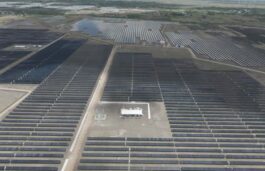
Repsol has begun construction of Delta II, the company’s largest renewable project to date. Once com-pleted, it will have a total capacity of 860 MW distributed over 26 wind farms located in the region of Ara-gon in northeastern Spain.
In the first construction stage, Repsol has begun work on two wind farms, La Cometa I and La Cometa II. These two wind farms, with a combined capacity of 60 MW, are scheduled to come into operation in the first quarter of 2022. They will have four and 12 wind turbines, respectively. Repsol also plans to begin work on three other wind farms in this large wind project this year.
Delta II is expected to be completed in 2023 and, at that time, it will supply electricity to around 800,000 homes. The renewable electricity generated will avoid the emission of more than 2.6 million tons of CO2 per year. Its development and start-up will provide a significant boost to the socioeconomic dynamism of the region.
In addition to Delta II, Repsol has the Delta wind project in Spain, also in Aragon, which has been fully operational since last March and has 89 wind turbines with an installed capacity of 335 MW distributed among eight wind farms. Construction of the Pi wind project, located between Palencia and Valladolid, with a total installed capacity of 175 MW, is expected to start this year.
Repsol is also developing three other photovoltaic projects in Spain: Valdesolar, whose construction be-gan in July 2020 in the municipality of Valdecaballeros (Badajoz) and which will have a total installed ca-pacity of 264 MW; Kappa, with three independent photovoltaic plants located in the municipality of Man-zanares (Ciudad Real) with a total installed capacity of 126 MW; and Sigma, with 204 MW, in the prov-ince of Cadiz.
As an operator, Repsol began the international expansion of its renewable business in 2020 with the sign-ing of a joint venture with Grupo Ibereólica Renovables that gives it access to a joint portfolio of assets in Chile in operation, construction or advanced development of more than 1,600 MW until 2025 and with the possibility of exceeding 2,600 MW in 2030.
In January of this year, both companies made progress in the construction of their first joint wind farm in the South American country, Cabo Leones III, with a capacity of 189 MW, with the shipment from the port of Bilbao of the main technological components of its wind turbines and with the entry into commer-cial operation of the first phase of the project. In addition, Repsol Ibereólica Renovables Chile recently finalized a PPA for another project in the country, the 180 MW Atacama wind farm.
During the presentation of its 2021-2025 Strategic Plan in November 2020, Repsol advanced its goal of being a multi-energy company with zero net emissions by 2050. A goal that will be achieved through a demanding roadmap with which it plans to reach 7,500 MW of low-emission generation by 2025 and dou-ble that figure by 2030.
Repsol currently has almost 3,300 MW of total installed low-emission generation capacity. By the end of the year, the company expects to have an additional 710 MW of capacity in operation or at an advanced stage of construction.
The investments foreseen in the 2021-2025 Strategic Plan amount to 18.3 billion euros. Of that, 30% – 5.5 billion euros – will be allocated to low-carbon initiatives. In line with this strategy, 40% of company spend-ing in the first quarter of 2021 was allocated to low-carbon projects.



























